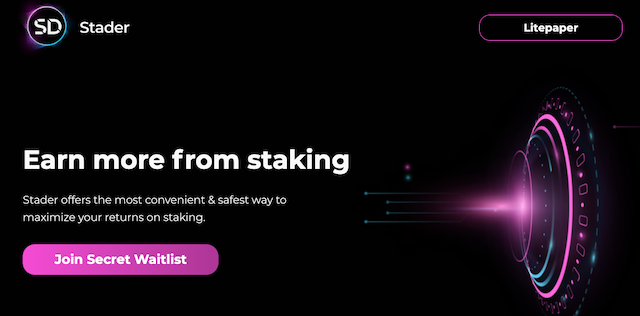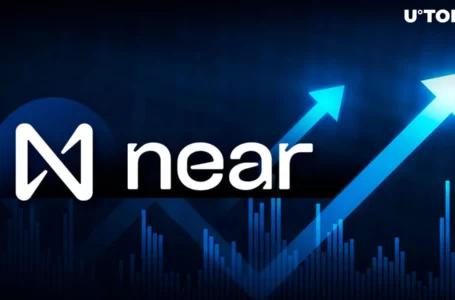
Stader (SD) operates as a chain-agnostic smart staking ecosystem. The protocol enables users to unlock liquidity while earning DeFi rewards via Liquidity mining protocols. The goal of the project is to take staking from the DeFi sector and make it a mainstream activity for savers and those seeking to generate long-term wealth.
Stader is a next-gen staking protocol that was built to make staking easy for everyone. The network currently has over 50k users in countries around the globe. The platform recently expanded its efforts to include a host of popular blockchains including Hedera, Polygon, Fantom, Near, Binance, Terra 2.0, and Terra Classic.
What Problems Does Stader Attempt to Fix?
Stader helped to solve a problem that has plagued DeFi users since day one. How do you use your tokens to secure passive returns without losing liquidity? In most instances, you stake your tokens in a smart contract. The staking contract will have a minimum amount and a staking lock up period. Notably, you are unable to access these funds during this time without penalties on most networks.

Stader unlocks your liquidity and enables you to stake and secure passive returns in a new way. This strategy unlocks liquidity through the use of a LP-token that represents your staked assets. As such, its pegged to the value of those assets. The token rises in value as the value of your staked assets grows. Best of all, this token can be used across the DeFi ecosystem to secure further profits.
Technical Roadblocks
Another major issue that Stader helps to alleviate are technical roadblocks to adoption. Staking is a new feature that can seem foreign to new users. Many users have complained that the staking process is too complicated for people.
Stader provides users with simple 1 click deployment. There is no need to learn a bunch of technical jargon or research staking steps. This approach makes it easy for anyone to secure returns in the DeFi market without losing time.
Centralization
Stader seeks to reduce centralization in the market. Staking protocols are already showing signs of centralization due to high technical and financial requirements. Smart staking protocols help to diversify staking networks. These protocols provide another layer of decentralization which improves network performance and transparency.
Benefits of Stader
Stader operates as a modular protocol that enables users to join staking networks with ease. The protocol improves the staking experience in many ways. The system introduces liquidity pools with high APYs to help you generate rewards while securing the network.
Stader operates as a non-custodial smart staking protocol. This designation means that your tokens remain in your wallet while staking. This structure is ideal for savers because you are never unable to access your tokens. Best of all this strategy means that hackers would have to target you personally to access your funds rather than a network wallet.
Chain Agnostic
Stader provides its services across a multitude of decentralized blockchains. The developers wanted to make the protocol chain agnostic to improve interoperability. As such, the network enables developers to interact with Stader Labs smart contracts to streamline the staking process considerably.
Interoperability concerns have been an issue for all early blockchain networks. Protocols like Stader help to alleviate the compartmentalization of the sector, which improves liquidity and earning opportunities. Consequently, it made sense to make Stader compatible with as many taking networks as possible.
Better Staking Experience
The staking process is improved by providing users with another layer of liquidity pool rewards. The network also requires users to stake for other reasons. You need to stake to vote on network upgrades, put forth a proposal, or qualify for certain competitions and bonuses. Users can secure airdrops staking as well.
Multiple Validators
Stader Labs allows users to stake across multiple validators at a time. There are a lot of reasons why a person would want to stake in this manner. For one, it improves returns and lowers penalties for users. When you stake using a validation pool, your penalties are split across all pool members. This structure enables people with less-than-perfect internet to participate. Additionally, this structure improves security.
How Does Stader Work?
Stader was built on the Terra blockchain. Terra was created as a decentralized financial infrastructure and blockchain protocol. The goal of the network was to operate as “Programmable money for the internet.” Today the network includes a host of features including a stablecoin protocol, an oracle system, smart contracts, and DeFi support.
Stader was designed from the ground up to support full smart contract programmability and DeFi capabilities. The network improves liquidity by separating the base capital and the rewards. Users can trade their LP token or use them to secure other passive income streams.
Token – SD
SD is the main utility and governance token for the network. The token serves multiple roles including as a way to pay for transaction fees and smart contract executions. The SD token can be staked to secure returns on the network. Additionally, SD is essential in community governance. Notably, SD has a total supply of 150,000,000 tokens.
Governance
Stader is in the midst of a governance launch. The network seeks to remain a community-led effort through the use of this community voting system. Per usual, users stake their tokens to gain access to voting and proposals. The system is weighted, which means you can stake more tokens to gain more voting power.
History
Sidhartha Doddipalli, Dheeraj Borra and Amitej Gajjala founded Stader Labs in Q1 2021. Interstingly, the platform secured $4 million during a seed funding round. The funding round was led by veteran blue chip investors, Pantera Capital. Stader originally launched on Terra blockchain but quickly expanded to Hedera, Fantom, and Polygonin 2022.
Final Thought
Stader appears to be positioned well as the majority of new blockchain networks are PoS systems. Stader could find that it becomes a major onramp for new users seeking an easy interface and access to multiple networks. As such, the platform is worth watching as the DeFi community continues to expand.


















